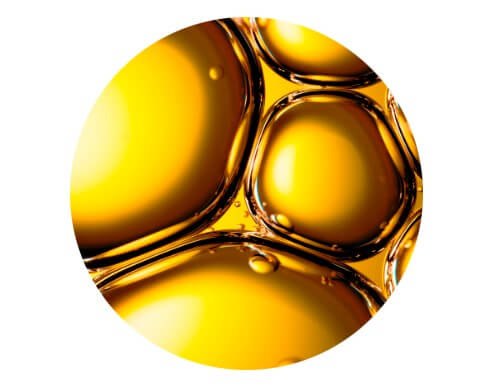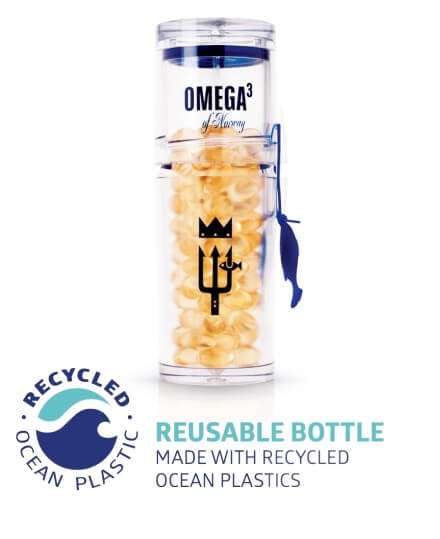For the same reasons that we choose to eat fresh, natural foods, and not processed ones, Omega3 of Norway values the importance of obtaining nourishment in its native and natural form.
FORMULATION

- Min. 95% Natural Triglycerides
- 330mg Eicosapentaenoic acid
- 220mg Docosahexaenoic acid
- 100mg Other Omega3 fatty acid
- Certified & 3rd party tested
- 12 Steps of molecular refinement
- 500g Compact Swiss Caps
- Neutralised taste profile

Omega3 fatty acids naturally occur as triglycerides, the molecular structure that fats and oils assume in both plants and animals. Omega3 fatty acids belong to the long chain polyunsaturated fatty acids (FA). This is how Omega3 fatty acids are preserved in Omega3 fish oil of Norway’s capsules. A triglyceride Omega3 fish oil not only ensures that their nutritional goodness is most easily absorbed by the body, but also provides insurance against the oxidization of Omega3 to protect their stability and efficacy.
Omega3 fatty acids are at the top of polyunsaturated fatty acids. Ongoing extensive studies and research indicate pure Omega3 fish oil benefits. In particular, the cardiovascular system and decreasing overall inflammation.
Among our sponsored and other Olympic athletes who take up to 6x capsules of Nordic natural Omega-3 fish oil daily, show inflammation levels were reduced by more than 90% after continuous daily consumption.
Due to the high quality nature of Norway Omega´s, wild water marine Omega-3 fish oil, a TGN Omega-3, marine oil in its natural state, over 90% natural Triglycerides and an average of 65% EPA/DHA fatty acids, Norway Omega fish oil delivers the highest quality multi-purpose Omega3 supplement. Reducing inflammation levels and supporting the cardiovascular system are just two of the key Omega3 fatty acids benefits.
- Immune System Omega-3 fish oil benefitThe anti inflammatory nature helps to support the immune system.
- Mind Omega3 fish oil benefitDHA has polyunsaturated fatty acids to help regulate mood and cognitive function.
- Mother & Child Omega3 fish oil benefitOmega 3 fatty acids are a crucial part of an expecting mothers and infants development nutritional daily intake.
- Skin & Hair Omega3 fish oil benefitOmega3 helps to boost the skins membranes, naturally hydrating the hair & skin cell membranes.
- Sport Omega3 fish oil benefitAforementioned – reducing the bodies inflammation levels, aids in faster recovery from work outs and sport sessions.
With so many Omega3 fatty acid supplements on the market, many producers are opting for an alternative form of Omega3 known as ethyl esters. This type of fish oil combines free fatty acids with ethanol to make the EPA and DHA levels more concentrated. Referred to as Omega3 fish oil concentrates, these ethyl esters are commonly used since they cost the least to produce. However, they are more difficult for the body to digest and process. Freshly squeezed orange juice or a concentrated one. The taste may be similar, but the physical makeup is entirely different, which one would you choose? Fish oil concentrate has been artificially manipulated to hit the same standards as fish oil triglycerides. Nordic natural Omega3 fish oil not only offers Omega-3 fish oil in its authentic form. Our formula is comprised of over 90% triglycerides while most other companies average around 60%. Presented with a choice of the two, what would you prefer?
THE CHOICE IS CLEAR
For the same reasons that we choose to eat fresh, natural foods, and not overly processed ones, Norwegian pure Omega fish oil values the importance of obtaining nourishment in its original form. Omega3 fatty acids naturally occur as triglycerides, the molecular structure that fats and oils take on in both plants and animals. This is how Omega3 fatty acid supplements are preserved in Norwegian Omega3 fish oil fatty acid capsules.
A triglyceride Omega3 fish oil not only ensures that their nutritional goodness is most easily absorbed by the body, but also provides insurance against the oxidation of Omega3 fish oil to protect their stability and efficacy. With so many Omega3 fatty acid supplements available in the market, many producers are opting for an alternative form of Omega3 fish oil known as ethyl esters. This type of fish oil combines free fatty acids with ethanol to make the EPA and DHA levels more concentrated. Referred to as fish oil concentrates, these ethyl esters are commonly used since they are the most cost effective to produce. However, they are artificial and more difficult for the body to digest and process. Would you prefer a freshly squeezed orange juice or concentrated one? The taste might be similar, but the physical make-up is distinctively different.
Fish oil concentrates are artificially manipulated to match the same standards as fish oil triglycerides. Omega3 fish oil of Norway not only offers organic Omega3 in its authentic form, but our formula is comprised of over 90% triglycerides while most other companies average around 60%. Presented with a choice of the two, what would you prefer?
WHAT ARE TRIGLYCERIDES IN DETAIL?
The National Academy of Sciences defines fats and oils as “complex organic molecules that are formed by combining three fatty acids with one molecule of glycerol”. Triglycerides, or triacylglycerols, are there to define this molecular structure combining three fatty acids (i.e. EPA and DHA) esterified (bonded) to a glycerol backbone. TGs are the natural molecular form that make up virtually all fats and oils in both animal and plants species.
The Omega3 fats present in fish are almost exclusively TGs1. Because free fatty acids are rapidly oxidized the TG structure offers greater stability to the fatty acids and prevents breakdown and oxidation.
ARE ALL FISH OIL CONCENTRATES, ETHYL-ESTERS?
The vast majority of fish oil concentrates sold globally; including those sold in North America are EPA and DHA EE concentrates. A small percentage of fish oil concentrates on the market are natural TGs.
Ethyl esters are produced with ethanol & industrial alcohol to form a synthetic substrate. Applying heat distillation resulting in a concentrated omega3 ethyl ester solution. Which reduces fatty acid oil integrity.
In the manufacturing of EE concentrates it is possible to convert the fatty acids back to TGs using food grade enzymes. This process, called glycerolysis, removes the ethanol molecule and re-esterifies the EPA and DHA fatty acids to a glycerol backbone. These are commonly referred to as re-esterfied or concentrated triglycerides (rTGs). The process of converting EE to TG is uncommon due to cost constraints adding 30-40 % to the end bulk oil cost. Therefore, the only rationale for omitting the glycerolizes step is cost cutting.
WHAT ARE ETHYL ESTERS & HOW ARE THEY MADE?
Fatty acid ethyl esters are a class of lipids that are derived by reacting free fatty acids with ethanol (alcohol).
Called trans-esterification, the process involves a reaction whereby the glycerol backbone of a TG is removed and substituted with ethanol4. The resulting EE allow for the fractional distillation (concentration) of the long chain fatty acids at lower temperatures. Commonly referred to as molecular distillation in the fish oil industry this step allows for the selective concentration of the EPA and DHA fatty acids to levels greater than found naturally in fish3. The resulting EPA and DHA concentrate is typically the end product that is subsequently marketed and sold as “Fish Oil concentrate”. This situation presents several issues. Because the term fat or oil refers only to TG the EPA and DHA ethyl ester concentrate is, by definition, no longer a fat or oil and is incorrectly marketed as fish oil. Because EEs rarely occur in nature this affects the way they are digested and absorbed in the body.
Norwegian pure Omega3 fish oil offers the cleanest and most refreshing taste and odor/scent profile possible. Thanks to Omega3 fish oil of Norway’s unique patented processing refinement technology, it is virtually tasteless and odor free.
To match the ultimate quality in an Omega3 wild water fish Marine Oil, we have naturally chosen Swiss Caps who hold the most highly regarded reputation in the industry, equipped with the latest production technology and ensuring only the highest quality and efficiency throughout all stages of production.
- Quality assurance, striving to surpass all industry criteria to the highest possible standards.
- Supreme over its competitors, Swiss Caps fish gelatine capsules for Omega3 are the most highly resilient and neutral in taste.
- Smaller and more comfortable compact 500mg softgel capsules – with fish gelatin.
Yes. Each flask is designed be gentler on our Earth with recycled ocean plastic, and to be reused by refilling with our pouches.
OUTSTANDING OMEGA3 OIL
12 STAGES OF PURIFICATION
How is the premium Omega3 refinement achieved?
Free fatty acids are removed as sodium soaps by mixing the crude oil with aqueous caustic soda solution. The sodium soaps are removed in a separator, and the refined oil washed with water and continuously dried under vacuum at a temperature not exceeding 100°C.
The purpose of this unique, extra distillaiton step is to remove all volatile environmental pollutants. A fraction of ethyl ester is added to the deacidified oil. When the ethyl esters are removed by distillation, they also carry with them the volatile environmental pollutants.
The ethyl esters are made by treating triglyceride oil with non-aqueous ethanol and a catalyst. After the reaction the glycerol is drained off, excess ethanol recovered, and the esters are washed with water and vacuum dried.
The boiling point of the ethyl esters is lower by working under high vacuum which makes it possible to seperate the long chained fatty acids from the short chained fatty acids. This technique makes it possible to produce oils with different concentration and ration of EPA and DHA.
Urea is added to the oil to form inclusion complex with saturated and monounsaturated fatty acid. The urea complex is removed by filtration, leaving the oil with an increased content of EPA and DHA.
The concentrated EPA and DHA in the ethyl ester form are blended with glycerol and converted to triglyceride concentrate by enzymatic esterification.
In order to crystallise the fat with the highest melting point, the temperature is lowered. The crystallised fats formed, which mainly is stearin and saturated fat, is removed by filtration. This is done to secure that the oil remains clear at lower temperature.
Bleaching absorbs colour pigments and oxidation products and is then removed from the oil by filtration. If the crude oil contains increased values of polyaromatic hydrocarbons (PAH), activated carbon will be added during this stage to remove these compounds.
The oil is deodorised by flushing steam through oil under vacuum and high temperature for a short period of time to remove the volatile compounds that are in the main cause for taste and odour.
Antioxidant in the form of natural tocopherols is added according to specification.
The oil is filled in new 190kgs steel drums and nitrogen blanketed.
The Omega 3 oil is now ready for encapsulation. With Swiss Caps – Fish gelatin 500mg.
NORWEGIAN, EU & US FDA APPROVED
FDA No: 18343674930 / NORWEGIAN-EU FOOD SAFETY No: M–428
Norwegian Food Safety Authority, Our Omega-3 oils and marine oils are manufactured on processing plants which have been approved by the European Union for export of fishery products to the union meaning that they have implemented, and are maintaining, food hygiene procedures based on the HACCP principles and is in compliance with the EU regulations 852/2004/EC, on the hygiene of foodstuffs, and 853/2004/EC setting forth specific hygiene rules for food of animal origin, as well as regulation 854/2004/EC laying down specific rules for the organisation of official controls on products of animal origin intended for human consumption.
EORI-GB163743501000 / EORI-DE702779552965027
QUALITY ASSURANCE
Conduct internal quality audits to ensure compliance with cGMP (current Good Manufacturing Practice) for API (Active Pharmaceutical Ingredients) and the authorities’ regulations for the production of marine-based Omega-3.
- Manufacture our Omega-3 fish oil ingredients in regulatory compliance with Norwegian US and European food safety requirements.
- Handle and process products under a competent Controlled HACCP system in accordance with the US FDA’s seafood HACCP regulation 21 CFR 123 and Norwegian and European authorities. This includes full quality control and assurance
- Maintain written product specifications, material safety data sheets (MSDS) and production records
- Maintain standard operating procedures.
- Implement detailed customer feedback, non-conformity, change control and Continuous Control schemes with Corrective Action Programmes.
- Ensure that batch records are reviewed by authorized personnel prior to release.
QUALITY CONTROL
In addition to quality assurance processes, we:
- Maintain compliance with industry standards established under the Omega-3 monographs in the EU Pharmacopoeia and GOED Omega-3 Voluntary Monograph.
- Impose strict limits for our operations; our goal is to stay ahead of regulatory developments, continually setting new standards in the industry.
- Perform multilevel testing; all products are subject to stringent internal specification testing, from the applied raw material to our finished products.
- Perform on-going stability studies to determine the shelf life of every product.
- Issue Certificates of Analysis, based on confirmation of quality and compliance, for each batch.
- Undertake validation of analytical methods.
- Employ 3rd party testing, including an analysis of all 209 PCB congeners, which will be included in the following year’s product specifications.
CITATIONS
- Ghasemi Fard S, Wang F, Sinclair AJ, Elliott G, Turchini GM. (2018). How does high DHA fish oil affect health? A systematic review of evidence. Crit Rev Food Sci Nutr. 58(18):3122-3130. doi: 10.1080/10408398.2017.1311971.
- Kaur G, Cameron-Smith D, Garg M, Sinclair AJ. (2011). Docosapentaenoic acid (22:5n-3): a review of its biological effects. Prog Lipid Res. 50(1):28-34. doi: 10.1016/j.plipres.2010.07.001.
- Hansen SN, Schelkle KM, Töllefsen KE. (2016). Effects of dietary lipid sources on the bioaccumulation and physiological effects of persistent organic pollutants in Atlantic salmon (Salmo salar L.) smolts. Sci Total Environ. 2017;575:727-736. doi: 10.1016/j.scitotenv.09.134.
- Bernasconi AA, Wiest MM, Lavie CJ, Milani RV, Laukkanen JA. (2020). Effect of Omega-3 Dosage on Cardiovascular Outcomes: An Updated Meta-Analysis and Meta-Regression of Interventional Trials. Mayo Clin Proc. 95(4):819-828. doi: 10.1016/j.mayocp.2020.01.030.
- Calder, P. C. (2015). Marine omega-3 fatty acids and inflammatory processes: Effects, mechanisms and clinical relevance. Biochimica et Biophysica Acta (BBA)-Molecular and Cell Biology of Lipids, 1851(4), 469-484.
- Mozaffarian, D., & Wu, J. H. (2018). Flavonoids, dairy foods, and cardiovascular and metabolic health: a review of emerging biologic pathways. Circulation research, 122(2), 369-384.
- Serhan, C. N. (2014). Pro-resolving lipid mediators are leads for resolution physiology. Nature, 510(7503), 92-101.






